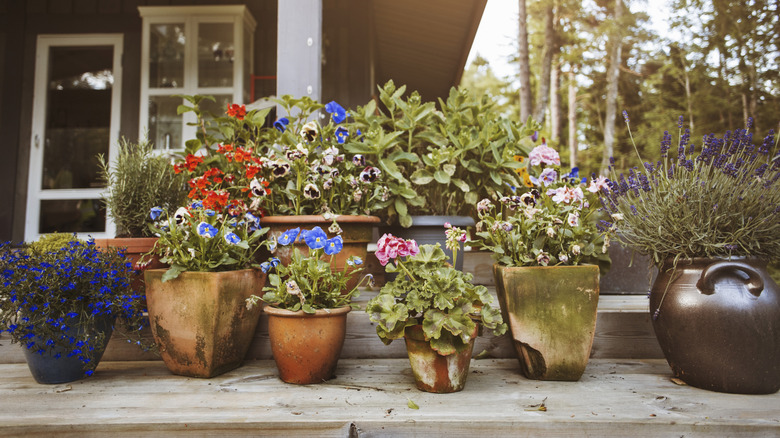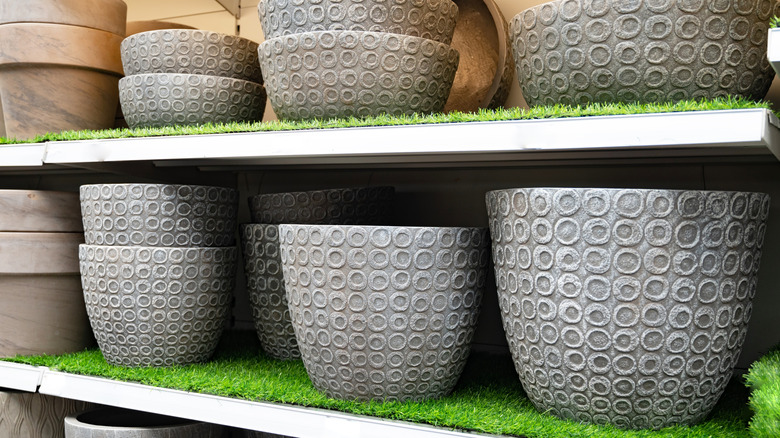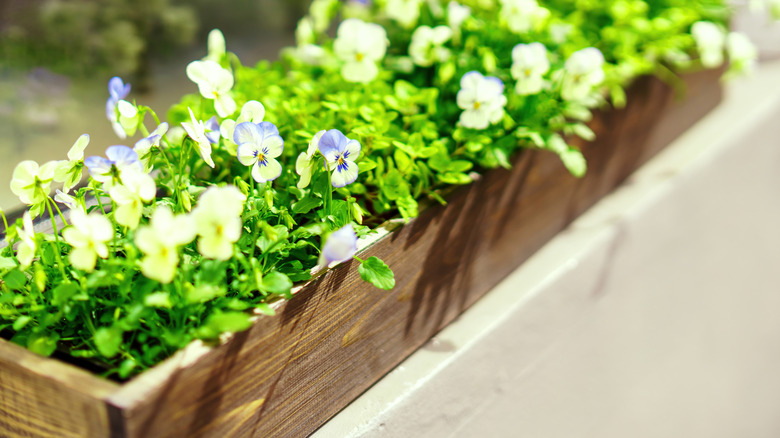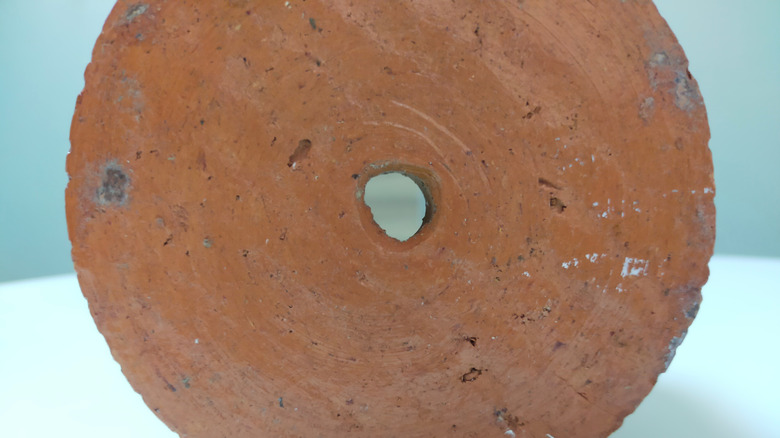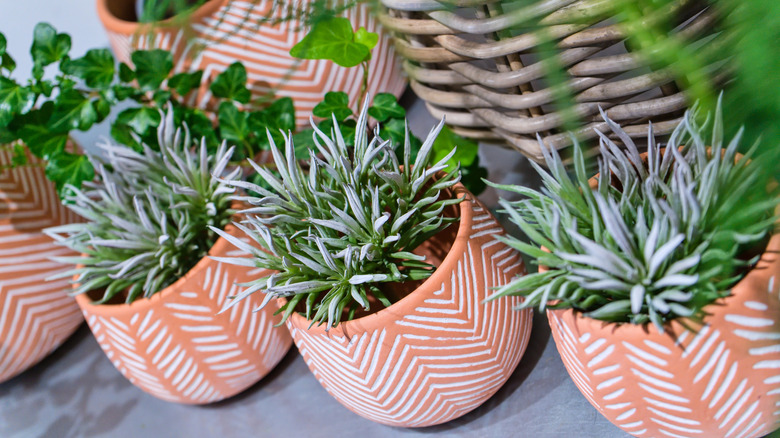Are You Buying The Right Planters? How To Select The Best Option For Your Garden
Some people are blessed to have plenty of garden space and fertile, nutritious soil. For the rest of us, there are containers. Container gardens allow for limitless versatility, allowing you to grow indoors, outdoors, on windowsills, and beyond. While any container can technically serve as a planter, one of the biggest mistakes with container gardens is using any old planter that looks nice. Choosing the right size, shape, material, and drainage level will go a long way toward keeping your plants happy and healthy.
At most gardening stores, there's a range of containers to choose from, from hanging baskets to trendy ceramic planters. Style is one obvious place to begin — especially if your container garden is indoors and you want the planters to match your aesthetic. But before you start designing a container garden, it's best to consider which plants you plan to grow in the containers, even if you haven't bought them yet.
Plants do best in planters that provide just enough space — not too much, not too little — for their roots, which may be long or shallow, depending on the species. Planters should also be made with a material that keeps the soil at the right level of moisture for the plant's needs. With that in mind, here's a closer look at the selection criteria that will help you pick the perfect planters for your container garden.
Selecting container materials
There are many planter materials to choose from, including terracotta, ceramic, wood, metal, fabric, fiberglass, plastic, stone, and concrete. Of these, unglazed terracotta, wood, fabric, stone, and concrete are the most porous. They allow the soil to shed moisture faster, which is ideal for plants that need to thoroughly dry out between waterings, like lavender, succulents, and cacti. On the other hand, glazed ceramic, metal, fiberglass, and plastic are a good choice for moisture-loving plants, like many of those from the tropics, because they're less porous and allow the soil to hold on to water longer.
Other key considerations are your local climate and the location of the container garden. Some materials, including terracotta and ceramic, are prone to cracking in freezing weather, so they're a safer choice for indoor planters. If you use them outdoors, you will need to winterize them or bring them inside for the winter. Other materials are vulnerable to heat and sunlight rather than the cold. Plastic can become brittle in high heat, for example, while metal pots can get hot enough to harm the plants inside. For year-round outdoor use, frost-proof plastic, concrete, and fiberglass are all good bets. And if you live in a humid area, a more porous planter material, like terracotta or fabric, may be ideal.
Lastly, consider durability. Wood eventually decays, and fabric typically only lasts a few years. On the other end of the spectrum, fiberglass, metal, and stone are incredibly long lasting and durable.
Deciding on the container size
The size of a planter is as important a consideration as its material. Firstly, size determines the planter's soil capacity and therefore dictates how much moisture it can hold. Small pots dry out faster and need to be watered more frequently. The same is true for tall, thin planters, which hold less soil volume than their wider counterparts.
However, a planter should also match the size of the plants and their roots. If you're shopping for a single plant, a good benchmark is to look for a planter that's roughly twice the size of the root ball to allow room for the roots to continue growing. When re-potting, choose a pot that's 2 to 3 inches larger in diameter. Too big of a planter can cause the plant to suffer from waterlogging or nutrient burn. Consider the depth of the roots, too. Some plants, like succulents and cacti, have shallow roots, so they can grow in shallower containers.
If you plan on having multiple plants in one container, make sure they have enough room to grow (and share similar soil, water, and sunlight requirements). On average, expect to fit around three to four plants into a 10- to 12-inch-diameter container, or up to nine plants in a 16- to 20-inch pot. These numbers may vary depending on plant size.
Choosing the shape and weight
Since any container can be a planter, there's no limit to the potential shapes you can choose from. That said, round, rectangular, and square containers are the most popular. Square planters have more surface area and hold more soil than round ones; they're also more stable and less likely to fall over outdoors than a round planter. However, some people prefer the look of round planters. And for certain types of gardens, like windowsills, rectangles just make the most sense if you have several plants growing in a row.
Shape isn't the only thing that determines how stable or sturdy a planter is. Weight also plays a role. Stone and concrete are the heaviest materials by far and are unlikely to ever tip over. Plastic, fabric, and fiberglass tend to be the most lightweight, and other materials are somewhere in between, depending on the type and size. It's also important to note that, while terracotta and ceramic can be pretty sturdy, they're also more vulnerable to chipping or cracking if they do fall over.
Keep in mind that the heavier the container, the more difficult it is to move around. That's why large stone and concrete planters typically stay in one spot for a very long time. Meanwhile, plastic and fabric are lightweight and suitable for hanging baskets or containers that need to be relocated frequently — many fabric pots even include handles.
Understanding drainage capacity
A container with a drainage hole is always better than one without it. The hole allows excess water to flow out of the soil so that the roots can access oxygen; without it, they can develop root rot and die. Outdoor planters need even more drainage than indoor ones since they have to contend with rainstorms, not only carefully measured watering sessions. Plants that need a lot of drainage, like orchids, may require containers with multiple holes. Remember that the porosity of the planter material also aids in drainage.
You don't have to avoid all hole-less planters. One option is to add the holes yourself as a DIY project. Or you can put down a layer of lava rocks on the bottom of the planter to provide a place for water to pool and only water less than one-third of the container's size. You can also double up, placing a planter with a hole inside of a more decorative pot without one.
Should you try a self-watering container? These planters come with water reservoirs that automatically keep the soil moist, potentially for weeks at a time. They are a handy option when used properly; you still need to monitor the soil water content, as some plants don't do well with constant moisture. One perk self-watering planters offer is that the reservoir doubles as a drainage area when you're top watering.
Consider the style and price
The last few factors to consider are style and price, and these are largely up to personal preference. Planters come in all sorts of design aesthetics, from bohemian to farmhouse to contemporary, as well as all kinds of colors and patterns. One particular time when you should consider color is when planting outdoors in hot climates: Darker colors absorb more heat. If you enjoy DIY projects, you might like to buy unglazed terracotta or concrete so you can paint your own design on top.
As far as prices go, plastic and terracotta planters tend to be quite affordable. Fiberglass, wood, metal, stone, and concrete planters are typically the most expensive. Price does often correspond to quality and durability. But if your plant is still quite new, it may be more budget-wise to use affordable planters until the plant reaches its full, long-term size — you may have to re-pot it every year or two, anyway.
